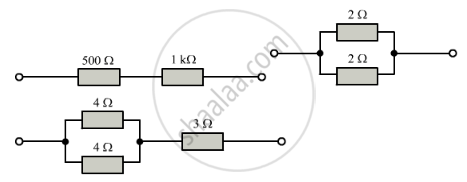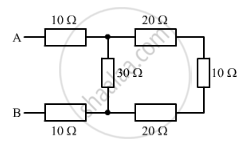Advertisements
Advertisements
प्रश्न
Find the expression for the resistors connected in series and write the two characteristics of it. (Draw figure).
उत्तर
Expression for the resistors in series:
R1, R2 and R3 are the three resistors connected in series between points C and D as shown in the figure above. I is the current and V is the PD across points
C and D.
Rs is the effective resistance in a circuit, and V1, V2 and V3 are the potentials across the three resistors such that
V = V1 + V2 + V3 ---- (1)
Using Ohm’s law, the total potential difference
V = I Rs
and V1 = IR1, V2 = IR2 and V3 = IR3
Substituting these values in Equation 1, we get
IRs = IR1 + IR2 + IR3
∴ Rs = R1 + R2 + R3
For n number of resistors connected in series,
Rs = R1 + R2 + R3 + R4 + ----- + Rn
Characteristics of a series combination of resistors:
a) The same current flows through each resistor.
b) The effective resistance of the combination is greater than any of the resistances in the combination.
c) The effective resistance of the combination is equal to the sum of individual resistors.
APPEARS IN
संबंधित प्रश्न
Complete the following :-
(a)

If the equivalent resistance is to be increased, then the number of resistances should be connected in
- Series
- Parallel
- Mixed arrangement
- None of the above
A battery of 9 V is connected in series with resistors of 0.2 Ω, 0.3 Ω, 0.4 Ω, 0.5 Ω and 12 Ω, respectively. How much current would flow through the 12 Ω resistor?
Two resistors of 4Ω and 6 Ω are connected in parallel to a cell to draw 0.5 A current from the cell.
(i) Draw a labelled circuit diagram showing the above arrangement.
(ii) Calculate the current in each resistor. What is an Ohmic resistor?
If the length of a wire is doubled by taking more of wire, what happens to its resistance?
How does the resistance of a wire change when:
its diameter is tripled?
If five resistances, each of value 0.2 ohm, are connected in series, what will be the resultant resistance?
V = IRTwo resistances X and Y are connected turn by turn : (i) in parallel, and (ii) series. In which case the resultant resistance will be less than either of the individual resistances?R = R1+ R2+ R3
Calculate the combined resistance in each case:

The diagram below shows part of a circuit:

If this arrangement of three resistors was to be replaced by a single resistor, its resistance should be:
(a) 9 Ω
(b) 4 Ω
(c) 6 Ω
(d) 18 Ω

In series combination of resistances ______.
What potential difference is needed to drive a current o f 1 A through a 5 Ω resistor?
What is the equivalent resistance between A and B in the given circuit (Fig?)

To increase the effective resistance in a circuit, the resistors are connected in _______________ .
State expression for Resistance connected in series.
Four resistances of 2.0Ω each are joined end to end, to form a square ABCD. Calculate the equivalent resistance of the combination between any two adjacent comers.
Calculate the value of the resistance which must be connected to a 15 ohm resistance to provide on effective resistance of 6 ohm.
Show how you would connect three resistors, each of resistance 6 Ω, so that the combination has a resistance of 4 Ω.
